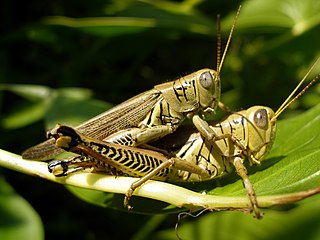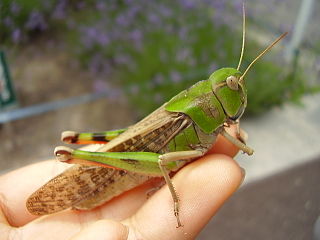
Orthoptera is an order of insects that comprises the grasshoppers, locusts, and crickets, including closely related insects, such as the bush crickets or katydids and wētā. The order is subdivided into two suborders: Caelifera – grasshoppers, locusts, and close relatives; and Ensifera – crickets and close relatives.

Locusts are various species of short-horned grasshoppers in the family Acrididae that have a swarming phase. These insects are usually solitary, but under certain circumstances they become more abundant and change their behaviour and habits, becoming gregarious. No taxonomic distinction is made between locust and grasshopper species; the basis for the definition is whether a species forms swarms under intermittently suitable conditions; this has evolved independently in multiple lineages, comprising at least 18 genera in 5 different subfamilies.

Grasshoppers are a group of insects belonging to the suborder Caelifera. They are amongst what are possibly the most ancient living groups of chewing herbivorous insects, dating back to the early Triassic around 250 million years ago.

The desert locust is a species of locust, a periodically swarming, short-horned grasshopper in the family Acrididae. They are found primarily in the deserts and dry areas of northern and eastern Africa, Arabia, and southwest Asia. During population surge years, they may extend north into parts of Southern Europe, south into Eastern Africa, and east in northern India. The desert locust shows periodic changes in its body form and can change in response to environmental conditions, over several generations, from a solitary, shorter-winged, highly fecund, non-migratory form to a gregarious, long-winged, and migratory phase in which they may travel long distances into new areas. In some years, they may thus form locust plagues, invading new areas, where they may consume all vegetation including crops, and at other times, they may live unnoticed in small numbers.

The migratory locust is the most widespread locust species, and the only species in the genus Locusta. It occurs throughout Africa, Asia, Australia and New Zealand. It used to be common in Europe but has now become rare there. Because of the vast geographic area it occupies, which comprises many different ecological zones, numerous subspecies have been described. However, not all experts agree on the validity of some of these subspecies.

The red locust is a large grasshopper species found in sub-Saharan Africa. Its name refers to the colour of its hind wings. It is sometimes called the criquet nomade in French, due to its nomadic movements in the dry season. When it forms swarms, it is described as a locust.

The differential grasshopper is a species of grasshopper belonging to the genus Melanoplus. It is found throughout northern Mexico, the central United States and southern Ontario, Canada. It is considered a pest over most of its range.

The Australian plague locust is a species of locust in the family Acrididae native to Australia, where it is a significant agricultural pest.

LUBILOSA was the name of a research programme that aimed at developing a biological alternative to the chemical control of locusts. This name is an acronym of the French title of the programme: Lutte Biologique contre les Locustes et les Sauteriaux. During its 13-year life, the programme identified an isolate of an entomopathogenic fungus belonging to the genus Metarhizium and virulent to locusts, and went through all the necessary steps to develop the commercial biopesticide product Green Muscle based on its spores.

The brown locust is a medium-sized small locust species in the monotypic genus Locustana. It is found in Southern Africa and shows classic gregarious behaviour with phase polymorphism on crowding.

The African rice grasshopper, Hieroglyphus daganensis is a medium-sized grasshopper species found in the Sahel region. Although not called a locust in English, this species shows gregarious behaviour and some morphological change on crowding and may become a moderately important pest species for small-holder farmers in the region.

Dociostaurus maroccanus, commonly known as the Moroccan locust, is a grasshopper in the insect family Acrididae. It is found in northern Africa, southern and eastern Europe and western Asia. It lives a solitary existence but in some years its numbers increase sharply, and it becomes gregarious and congregates to form swarms which can cause devastation in agricultural areas. The species was first described by Carl Peter Thunberg in 1815.

Schistocerca americana is a species of grasshopper in the family Acrididae known commonly as the American grasshopper and American bird grasshopper. It is native to North America, where it occurs in the eastern United States, Mexico, and the Bahamas. Occasional, localized outbreaks of this grasshopper occur, and it is often referred to as a locust, though it lacks the true swarming form of its congener, the desert locust.

Patanga succincta, the Bombay locust, is a species of locust found in India and southeast Asia. Usually a solitary insect, only in India has it has exhibited swarming behaviour. The last plague of this locust was in that country between 1901 and 1908 and there have not been any swarms since 1927. It is thought that the behaviour of the insects has altered because of changing practices in agricultural land use.

Valanga nigricornis, the Javanese grasshopper, is a species of grasshopper in the subfamily Cyrtacanthacridinae of the family Acrididae. It is found in southeastern Asia, the type location being Singapore. It was first described by the German zoologist Hermann Burmeister in 1838. There are more than twenty subspecies, most of which are endemic to different island groups; the subspecies V. nigricornis nigricornis is the type for the genus Valanga.

Locusta migratoria manilensis, commonly known as the Oriental migratory locust, is a subspecies of the migratory locust in the family Acrididae. It is sufficiently different in size and structure from the African migratory locust to be considered a distinct subspecies of the migratory locust. It is found in southeastern Asia and is an important agricultural pest in the region. It is normally a solitary insect but when conditions are suitable, it enters into a gregarious phase when the young form into bands which move together and the adults into swarms. Although outbreaks may have recently been fewer in number and size because of changes in agricultural practices and better locust detection, the insects remain active as crop pests and the potential for outbreaks is still present.

Locusta migratoria migratorioides, commonly known as the African migratory locust, is a subspecies of the migratory locust family Acrididae.

Valanga irregularis belongs to the family Acrididae. The distribution is restricted in the Australian tropics and subtropics. The species is the largest grasshopper of the continent. Usually the animal lives a solitary mode of life.

Schistocerca cancellata is a species of locust in the subfamily Cyrtacanthacridinae. It is the major swarming species in subtropical South America. This species shows typical locust phase polymorphism. Solitarious nymphs are green, but gregarious ones are yellow with a black pattern. There are morphological differences between solitarious and gregarious adults. For many years the two phases were believed to be different species and the gregarious form was mistakenly identified as S. paranensis. The solitary phase is found in South America between 18°S and 35°S. Plagues originate in a desert and semi-desert zona permanente in NW Argentina, SE Bolivia and W Paraguay, when good rains allow successful breeding, followed by gregarisation. Swarms of gregarious adults may then migrate into crop growing regions.























